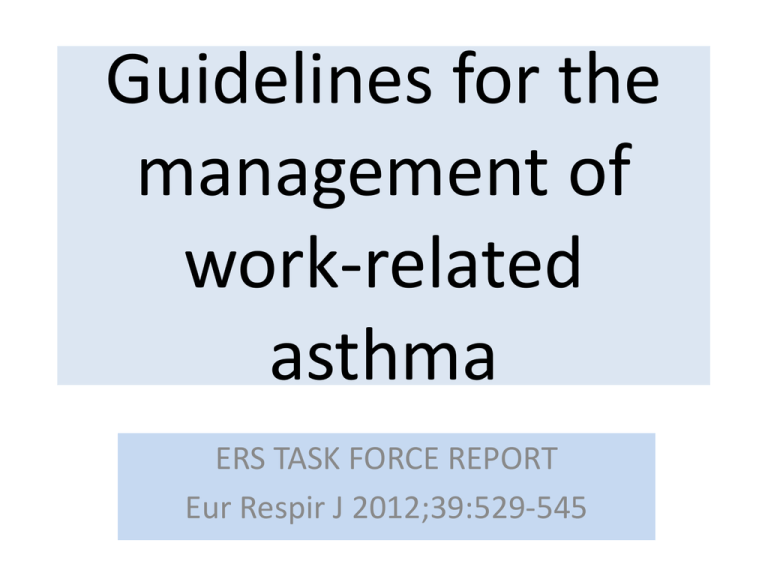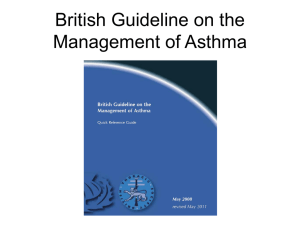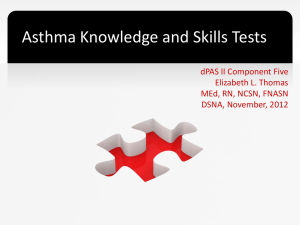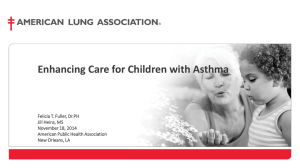11. Guidelines for the management of work-related asthma
advertisement

Guidelines for the management of work-related asthma ERS TASK FORCE REPORT Eur Respir J 2012;39:529-545 OCCUPATIONAL EXPOSURE • • • • • Pneumoconiosis Work-related asthma Work-related COPD Work-related infections Work-related rhinitis Mr AD: 32 years platinum mine worker Working underground since 2011 Jan 2012: Chest tightness Rx: Asthavent and TB treatment for 7 months Smoker for 3 years; quit Jan 2012 Always using dust mask and ‘respirator’ since Aug 2012 3 Jan 2013: serious ‘asthma attack’ and referred to specialist but no asthma found No known allergies or asthma symptoms before / no family history of asthma Pre: Post %Chng FEV1: 78% 90% 15% RV: 147 % Raw: 206 % Skintest: House dust mite 4+ IgE: 504 (N= 0-22) MELISA platinum LPT : 1 (neg) Dx: Work-related asthma ERS TASK FORCE REPORT Guidelines for the management of work-related asthma Work-aggravated asthma Worsening of pre-existing asthma due to causes and conditions attributable to a particular occupational environment and not to stimuli encountered outside the workplace Worker has a concurrent history of asthma that was not induced by an exposure in the workplace Aggravation is typically due to an occupational irritant Some workers may, after a latent period, experience worsening of asthma with regular daily exposure to agents that can cause IgEmediated allergies in others Mr TN: 27 years chrome mine worker Underground 2006 until 2012 May 2012: Dyspnoea/wheezing Rx: LABA/ICS Dyspnoea improve but still severe dyspnoea during running (+/- 200 m) No allergies or asthma symptoms before/ No family history of asthma Pre Post %change FEV1: 65% 80% 22% RV: 206% Raw: 286% Skin test: grass 4+ maize 3+ feathers 2+ IgE: 1189 (N= 0-22) Rx: Prednisone, LABA/ICS, Venteze, Loratadine Dx: Work-related asthma Occupational asthma Occupational asthma is a disease characterised by variable airflow limitation and/or hyperresponsiveness associated with inflammation due to causes and conditions attributable to a particular occupational environment and not to stimuli encountered outside the workplace • IgE-mediated asthma after a latency period • Irritant asthma with or without a latency period, including reactive airways dysfunction syndrome (RADS) which results from high exposure • Asthma due to a specific occupational agent with unknown pathomechanism Mr JJ: 49 years Vanadium mine worker Non smoker Work in production unit / very dusty No dyspnoea at rest / mild cough Dyspnoea with moderate exercise Allergies: trees 3+ wheat 3+ maize 2+ Pre Post %change FEV1: 35% 41% 18% RV: 334% Raw: 126% Diffusion: 75% Dx: 1. Work-related asthma 2. Work-related COPD Work-related COPD Welding fumes Isocyanates Potroom Aluminium Cadmium Metals Ammonia Tobacco smoke Wood dust Cotton Endotoxin Vanadium Coal dust • • • • • • • Potential causes of OA Can also cause COPD without any acute symptoms to suggest asthma Some workers with symptoms suggestive of OA develop predominantly fixed airway obstruction more suggestive of COPD Some of these may improve over long periods away from exposure, but some do not The pathology of these workers developing predominantly fixed airway obstruction is unknown Symptoms in asthmatics that do not improve during weekends or holidays may indicate a progressive course typical of COPD Some overlap between OA and COPD Key questions of the guidelines for the management of work-related asthma • Key question1: How are work-related asthma cases diagnosed and how should they be diagnosed ? • Key question 2: What are the risk factors (host and exposure) for a bad outcome ? • Key question 3: What is the outcome of different management options in subjects who are already affected ? Key question 1: Diagnosing work-related asthma 1. Tests that separate asthma from normality or other lung diseases 2. Tests that identify the workplace as the cause of respiratory symptoms 3. Tests that identify the agent causing workrelated asthma Tests that separate asthma from normality or other lung diseases • Spirometry and tests for reversibility • Increased diurnal variation in PEF • Sputum eosinophilia • Exhaled nitric oxide Tests may all be normal in individuals with occupational asthma confirmed with specific challenge tests No measure of lung function or inflammatory marker is sufficiently sensitive to be used to exclude occupational asthma suggested by history Tests that identify the workplace as the cause of respiratory symptoms • Screening questionnaires for respiratory symptoms • Serial peak flow measurements • Pre- to post-shift changes in lung function • Changes in NSBHR at and away from work PEF: minimum criteria are >3 weeks of usual work exposure with measurement at least 4x/day; or 8 work days and 3 rest days with 2-hourly measurements Pre- and post-shift measurements of FEV1 and changes in NSBHR after a twoweek removal from work are less sensitive and less specific Tests that identify the agent causing workrelated asthma • Specific IgE • Skin-prick measurements • Specific inhalation challenge (SIC) Both skin-prick and specific IgE are highly sensitive for detecting type 1 sensitisation and occupational asthma caused by most high molecular weight agents but are not specific for diagnosing occupational asthma Carefully controlled SIC tests come closest to a gold standard test for many agents causing occupational asthma A negative SIC test in a worker with otherwise good evidence of occupational asthma is not to exclude the diagnosis Specific inhalation challenge Platinum salts: -specific -safe but late reactions possible -performed in a clinical setting where emergencies can be treated adequately -sensitivity higher than that of skin prick tests -workers with a systemic reaction in skin tests and with obstructive airway disease should not be tested Bronchial hyper reactivity to metacholine is of little value for a prediction of the reaction in bronchial provocation tests Does not correlate with skin and bronchial reactivity to platinum salts Consequences of occupational asthma development for the individual worker Degree of proof required depends on the consequences of OA development for the individual worker • If the worker is likely to lose his job OA should be confirmed physiologically and the specific agent causing the OA should be identified • If it is possible to relocate the worker away from exposure without loss of income, a precise diagnosis is less important • Criteria for legal compensation vary between different administrations and different countries Key question 2: What are the risk factors (host and exposure) for a bad outcome • • • • • • • • Lungfunction Duration of exposure Atopic status Smoking status Gender Age Agent SIC pattern • Lower lung volumes, higher NSBHR, or a stronger asthmatic response to SIC at diagnosis are risk factors for a bad OA outcome • Longer symptomatic exposure relates to a worse OA outcome • No relationship between atopy and OA outcome • Smoking at time of diagnosis not related to OA outcome • Data consider gender in OA outcome is contradictory • Older age is associated with poorer OA prognosis • HMW agents seem to cause longer duration of BHR compared with LMW Key question 3: Outcome of different management options in subjects who are already affected • Persistent exposure • Pharmacological treatment • Complete avoidance of exposure • Relocation • Personal protective equipment • Persistent exposure to the causal agent is more likely to be associated with asthma and NSBHR persistence, as well as an accelerated decline in FEV1, compared with complete avoidance of exposure • Insufficient evidence that Rx with ICS/LABA is able to prevent the longterm deterioration of asthma in subjects who remain exposed to the agent causing OA • Substantial long-term morbidity as complete avoidance of exposure to the causal agent results in symptom recovery and resolution of NSBHR in less than 33% of affected people Key question 3: Outcome of different management options in subjects who are already affected • Persistent exposure • Pharmacological treatment • Complete avoidance of exposure • Relocation • Personal protective equipment • Reduction of exposure to the causal agent can lead to improvement or resolution of symptoms and NSBHR but is less beneficial than cessation of exposure • Personal respiratory equipment can result in an improvement but not a complete suppression of respiratory symptoms and airway obstruction in the short-term Recommendations (1) 1. Occupational asthma should be confirmed by objective physiological tests and in cases of allergic pathogenesis by immunological tests (S/H) 2. All adults with new, recurrent or deteriorating symptoms of asthma, COPD or rhinitis should be asked about their job, materials with which they work and whether they improve when away from work (S/H) 3. Health practitioners should consider that early recognition and diagnosis of work-related asthma is recommended as a shorter symptomatic period after diagnosis is associated with a better outcome (S/H) 4. Smoking habit and atopy should not be taken into account when assessing the prognosis for medical legal purposes (S/M) Recommendations (2) 1. Patients, physicians and employers should be informed that persistence of exposure to the causal agent is likely to result in a deterioration of asthma symptoms and airway obstruction (S/M) 2. Patients and their attending physicians should be aware that complete avoidance of exposure is associated with the highest probability of improvement but may not lead to a complete recovery from asthma (S/M) 3. The use of respiratory protective equipment should not be regarded as a save approach, especially in the long-term and in patients with severe asthma (S/L) 4. Anti-asthma medications should not be regarded as a reasonable alternative to environmental interventions (S/VL)






